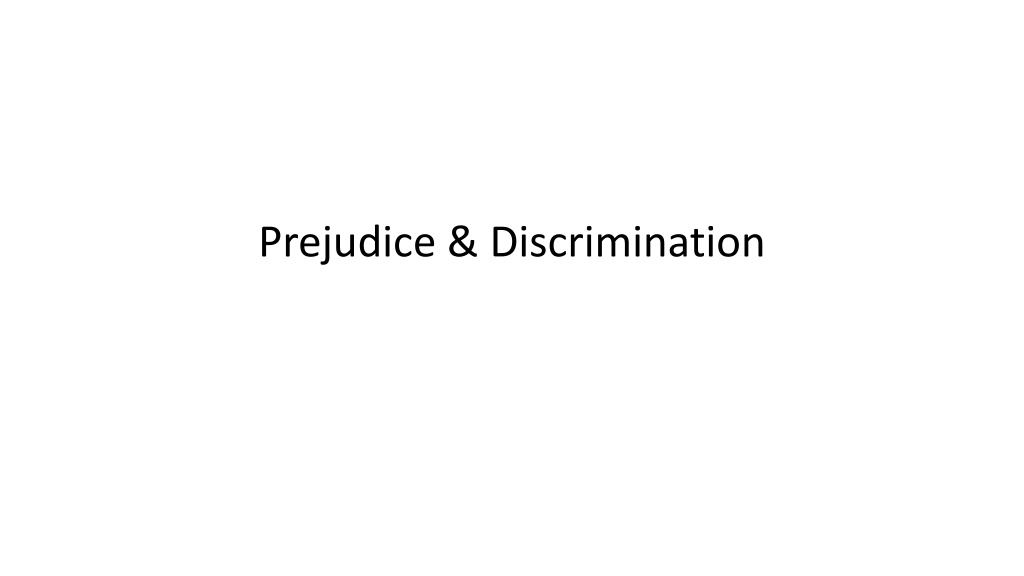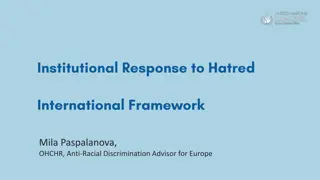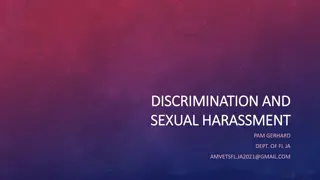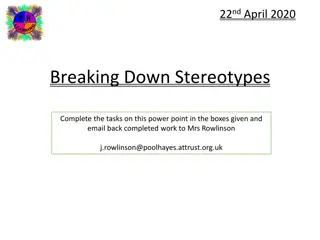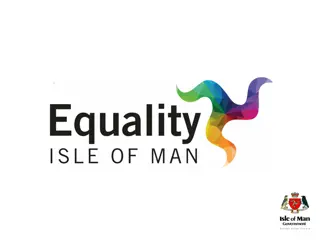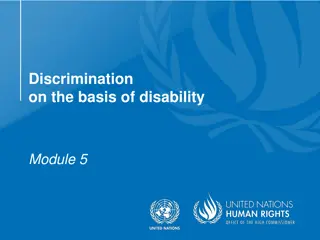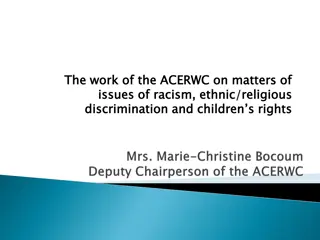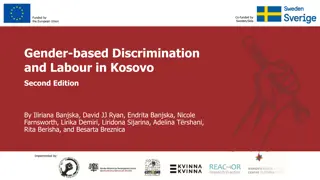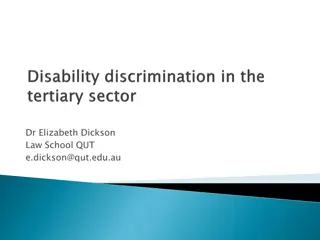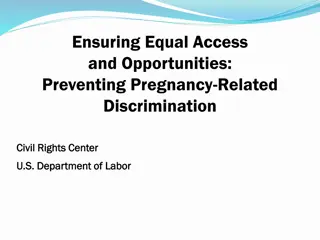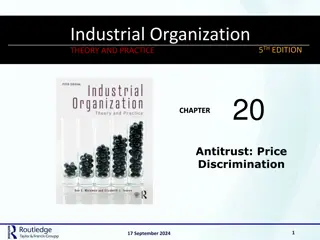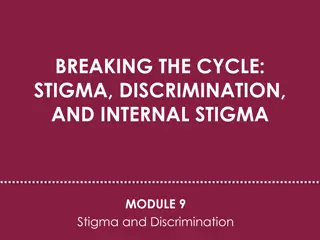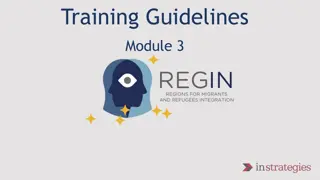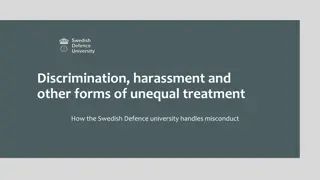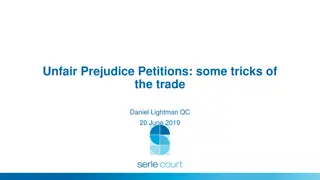Understanding Prejudice and Discrimination: Sources, Consequences, and Solutions
Explore the nature and power of prejudice, including its social, motivational, and cognitive sources, as well as the consequences of discrimination. Learn about stereotypes, racism, and discrimination, with a focus on how societal attitudes impact marginalized groups. Discover solutions to combat prejudice and promote inclusivity in diverse communities.
Download Presentation

Please find below an Image/Link to download the presentation.
The content on the website is provided AS IS for your information and personal use only. It may not be sold, licensed, or shared on other websites without obtaining consent from the author. Download presentation by click this link. If you encounter any issues during the download, it is possible that the publisher has removed the file from their server.
E N D
Presentation Transcript
Outline What is the nature and power of prejudice? What are the social sources of prejudice? What are the motivational sources of prejudice? What are the cognitive sources of prejudice? What are the consequences of prejudice? Solutions to prejudice
What is the nature and power of prejudice? Prejudice A preconceived negative judgment of a group and its individual members. (Mostly) Negative attitude affective component Can you think of any positive prejudical attitudes?
What is the nature and power of prejudice? Prejudice Explicit and implicit prejudice https://implicit.harvard.edu/implicit/ Explicit attitudes can be change with education but implicit attitudes are resistant to change (but not impossible). Gender, race, age, disability, nationality, etc
What is the nature and power of prejudice? Stereotypes The negative beliefs marking prejudice. A cognitive component. Generalizing is a key. Resistant to change. Does it have to be accurate and negative? Can you give an example of stereotypes in daily life?
What is the nature and power of prejudice? Discrimination Unjustified negative behavior. It is a behavior. behavioral component Racism and sexism are the most types of discrimination (we ll talk about it in a bit.)
What is the nature and power of prejudice? Racism An individual s prejudicial attitudes and discriminatory behavior toward people of a given race. Blacks, Hispanics, Asians, etc In Turkey, do you believe that Syrian refugees suffer from racism? Modern (subtle) Racism: exaggerated reactions or patronization
What is the nature and power of prejudice? Racism Exaggerated reaction? https://www.youtube.com/watch?v=ge7i60GuNRg
Modern Racism Scale Discrimination against blacks is no longer a problem in the United States. It is easy to understand the anger of black people in America. Blacks have more influence upon school desegregation plans than they ought to have. Blacks are getting too demanding in their push for equal rights. Blacks should not push themselves where they are not wanted. Over the past few years, blacks have gotten more economically than they deserve. Over the past few years, the government and news media have shown more respect to blacks than they deserve.
What is the nature and power of prejudice? Racism Blacks are lazy. Germans are hardworking. British people are cold. Blacks have amazing music talent. Middle Easterns are very traditional. French people are great at kitchen.
What is the nature and power of prejudice? Sexism Gender role norms: People s ideas about how women and men ought to behave. Gender stereotypes: People s beliefs about how women and men do behave. https://www.youtube.com/watch?v=tAQcvY6ZdOs Norms=prescriptive (s k kurallar koyan) Stereotypes=descriptive (tan mlayan)
What is the nature and power of prejudice? Sexism Successful Beautiful Skinny Bulky Active Listener Moody Breadwinner Emotional Assertive Hardworking Maternal Quiet Hot-temperedness Self-sacrificing Smart
What is the nature and power of prejudice? Sexism Hostile Sexism: Expression of an aggresion and often with violance. Benevolent Sexism: Women are fragile and needy. Women should be the caregiver of a child. Cheater wifes should be physically punished. There are some women who deserve to be beaten. There are some dress codes that women should follow. Women should be protected by men.
What is the nature and power of prejudice? Sexism Research consistently shows that doctors are less likely to take women s pain seriously. They may believe that their female patients are faking or exaggerating their pain, or that they are reacting with excessive emotion to relatively minor pain. This can lead to misdiagnoses, and even be fatal. Women are less likely to be diagnosed with heart attack as well.
What is the nature and power of prejudice? Racism and sexism are not the only ones. Ageist prejudices: Ageism can be directed at both young and old people. For example, prejudices against young people suggest they are uninformed, ignorant, or impulsive. This can be used to mistreat or ignore them. Prejudice against older people may be used to deny them employment, remove their autonomy, or even abuse them. Elder abuse remains common.
What is the nature and power of prejudice? Ableist prejudices: Prejudicial attitudes about people with disabilities remain common. For instance, some people mistakenly believe that all people with disabilities have caregivers or that disabilities make people weak or meek. Others believe disabilities are uncommon, or that people with disabilities don t have the same desires or rights as others. This is often used to support discriminatory or unfair policies. For example, people with disabilities faced forced sterilization for much of American history.
What is the nature and power of prejudice? Anti-LGBTQ+ prejudice: Prejudicial beliefs about the behavior and attitudes of LGBTQ+ people have long been used to support discriminatory policies. For example, the notion that transgender people are merely donning the attire of the opposite gender has been used to stoke fears about transgender people using bathrooms consistent with their gender identity. Beliefs that non-heterosexual people are less moral or less committed to family relationships figured prominently in the refusal to allow them to marry.
What are the social sources of prejudice? Social Inequalities Unequal status breeds prejudice. Prejudice helps to justify superiority and to blame the victim. Social dominance orientation: a motivation to have one s group dominate other social groups. Mostly supporters of hierarchies.
What are the social sources of prejudice? Socialization Influence of family and social group. The authoritarion personality: tendency to discipline, obedience, respect for authority and intolerance of outgroups. Ethnocentrism: Yulin Festival? Militant extremism and political polarization. Conformity: type of social influence involving a change of a belief.
What are the social sources of prejudice? Institutional Supports Segregation and reinforcement. Until 1970s, banks continously declined mortgage applications of unmarried women. Often unintended and unnoticed (internalization?). Face-ism and body-ism
What are the motivational sources of prejudice? Frustration and Aggression The Scapegoat Theory: When the cause of frustration is unclear, we often redirect our hostility. Displaced aggression Living standards and openness to diversity is related. Witch hunt, 9/11 events, etc A child raised in a forest can have stereotypes and prejudical beliefs? Realistic group conflict theory: assumes that prejudice arises from competition between groups for scarce resources.
What are the motivational sources of prejudice? Feeling Superior to Others Social Identity Theory: Our answer to Who am I? that comes from our group membership (Tajfel). What are your social identities? (I am ..) We categorize (They are Hindu), we identify (I am Muslim) and we compare (I am better than her). Ingroup: US Outgrup: THEM Sometimes the boundary between self and grup blurs (Gezi, football, )
What are the motivational sources of prejudice? Feeling Superior to Others Ingroup bias: The circle that includes us and exclude them The tendency to favor one s own group. Positive self-image, arise in self-esteem, favoritism, self-serving bias Does positive feelings for our own groups need to be mirrored by equally strong negative feelings for outgroup? Need for status, self-regard and belonging: terror management theory (self-protective response to reminders of their mortality.)
What are the motivational sources of prejudice? Motivation to Avoid Prejudice Prejudice thoughts and beliefs are not necessarily automatic. People may aware their prejudical thoughts/behaviors and may deliberately avoid them. It is a good step to change prejudical beliefs. But your facial muscles might say something different Internal (because prejudice is wrong) vs. External (because social desirability).
What are the cognitive sources of prejudice? Prejudice is also by-product of our normal thinking processes. In a practical manner, they actually help us to simplify our complex world.
What are the cognitive sources of prejudice? Categorization Classifying people into groups. Mostly spontaneous (especially in limited amount of time, when they are preoccupied, tired and under pressure). What can be possibly the reason why the most common types of prejudice are racism and sexism?
What are the cognitive sources of prejudice? Percieved Similarities and Differences Outgroup Homogeneity Effect: a sense that the outgroup all alike and different from us The less our familiarity, the more we stereotype (so can we expect that Turkish people prejudice more towards, for instance, Americans? If so, why Turkish people have highly negative prejudical thoughts towards Syrian refugees who can be considered as similar to our culture/people?)
What are the cognitive sources of prejudice? Distinctiveness Distinctive people or occurrances capture attention and distort judgments (people with blue hairs or airplane crashes)
What are the cognitive sources of prejudice? Distinctiveness Your difference from the others in terms of gender, race, ethnicity, etc Stigma consciousness: a person s expectation of being victimized by prejudice or discrimination. Illusory correlations: overestimating the frequency of events (airplane crashes) and making illusory correlations (being a murdered and mentally ill). Rape victims
What are the cognitive sources of prejudice? Attribution Just world belief: a fundamental attribution error that happens when our attention focuses on the person, not the situation (i.e. Market lines) The more people assume that human traits are fixed dispositions, the stronger are their stereotypes. Group-serving bias: when explaining acts by members of other groups, we assume the worst (He is not donating because he is selfish). Whereas, we grant members of our own group (He is not donating because he takes care of his old father and they need money).
Ingroup Outgroup Attitude Favoritism Belittling Perceptions Heterogeneity Homogeneity Attributions for negative behavior To situations To dispositions Karen donated the money that she found yesterday. She is really helpful. Billy was yelling his employee. He is always angry.
What are the consequences of prejudice? Self-Perpetuating Prejudgments Prejudgments guide our attention and memories. (Women misremember their math grade.) When a group behaves as expected, our beliefs are confirmed (See, I know that Greek people are lazy.) So, stereotypes influence how we interpret someone s behavior. What we do when we face inconsistant behavior? (a hardworking Greek) Subtyping: Thinking that specific person as an exception Subgrouping: Forming a new stereotype about this subset.
What are the consequences of prejudice? Stereotype Threat A self-confirming apprehension that one will be evaluated based on a negative stereotype. Cultural stereotypes cause women do worse in math test. Reasons are possibly stress, self-monitoring and suppressing unwanted thoughts (regulating one s emotions needs energy). If negative stereotypes disrupt performance, could positive stereotypes enhance it?
What are the consequences of prejudice? People sometimes maintain general prejudices without applying their prejudice to particular individuals.
Solutions to Prejudice Self esteem hypothesis, is that when people have an appropriate education and higher self esteem, their prejudices will go away. (??) Contact hypothesis, which states that the best answer to prejudice is to bring together members of different groups so they can learn to appreciate their common experiences and backgrounds. (Allport) Cooperation hypothesis, holds that conflicting groups need to cooperate by laying aside their individual interests and learning to work together for shared goals. Legal hypothesis, is that prejudice can be eliminated by enforcing laws against discriminative behavior.
Summary What is the nature and power of prejudice? Prejudice Stereotypes Discrimination Racism Sexism What are the social sources of prejudice? Social Inequalities Socialization Institutional Supports
Summary What are the motivational sources of prejudice? Frustration and Aggression Feeling Superior to Others Motivation to Avoid Prejudice Categorization Perceived Similarities and Differences Distinctiveness Attribution What are the consequences of prejudice? Self-Perpetuating Prejudgments Stereotype Threat Solutions to Prejudice
